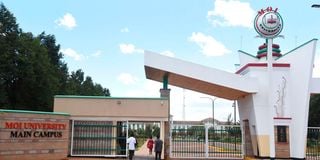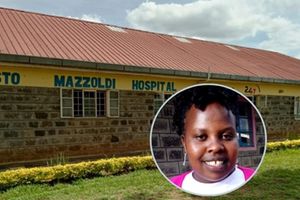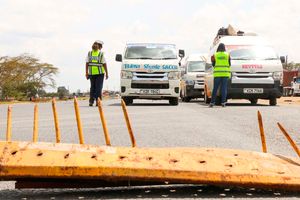
The entrance to Moi University's main campus in Kesses, Uasin Gishu County on February 8, 2024.
Last week, the Parliamentary Education Committee went to Moi University in Eldoret to establish the status of things at the institution that has been in the news for weeks for all sorts of reasons. A few days earlier, the Parliamentary Investment Committee on Education and Governance led by Jack Wamboka had convened a session in Parliament to interrogate and find out the going
The outcomes of these were extremely unpleasant. Their verdict was that Moi University was collapsing due to bad governance, reckless resource management, outright theft, looting and lack of vision and foresight. Consequently, the investment committee directed the Auditor-General to conduct a forensic audit on the university.
Even so, available evidence is damning. Independent investigations and documentary evidence show a university on its death bed due to years of gross mismanagement, greed, recklessness, nepotism and bad decisions. First, when the Parliamentary Education Committee (PEC) went to the university, the academic and non-academic staff who have been on strike for two months blocked the team led by Tinderet MP Julius Melly from meeting the university management and demanded an audience with them.
The union officials representing academic and non-academic employees tabled a catalogue of complaints against the university management, summing up that they were operating under piteous conditions. The employees have not been paid for months while statutory and other deductions, including medical insurance and pension, as well as Sacco and bank loans, have not been remitted to the respective agencies and lenders for years.
When the committee completed the tour of the university, members were bewildered at the depth of rot at the institution. The university facilities had collapsed. Lecture theatres, hostels and dining halls were in terrible condition. Worse, the sewerage system had collapsed, and the toilets were stinking. One of the MPs described the university as a public health crime scene.
At the end of the visit, the committee declared that the problem with Moi University was bad governance. And that is the crux of the matter. The university council led by Dr Humphrey Njuguna and the vice-chancellor, Prof Isaac Kosgey, have failed to address the issues raised by the staff and students. Their appearances before the parliamentary committees have not shined light on any strategy to tackle the myriads of challenges facing the institution.
The secretary of University Academic Staff Union (Uasu) Moi Chapter, Dr Busolo Wegesa, describes the university as an institution under receivership and likely to fall any time.
“Our greatest concern is that nobody in government wants to resolve the Moi University crisis, it’s as if there is a conspiracy of silence to kill the university,” he says. The Weekly Review’s interviews with multiple sources indicate that Moi University has been brought down systematically over a long period of time through reckless financial decisions and outright theft and looting. A few examples will illustrate.
Lack of students
Sometimes in the 2000s, Moi University embarked on an expansion spree and set up several satellite campuses to attract students under the then lucrative parallel degree programmes. In 2008, it set up Odera Akang’o University Campus in Yala, Siaya County, some 150 kilometres away. The campus collapsed due to lack of students and has since been taken over by the nearby Maseno University.
At the same time, Moi University opened up a campus in Mombasa, in itself, a ridiculous venture. The university bought a private property, a residential house, at a cost of Sh100 million, which was to be used as administration offices but then went ahead to rent space elsewhere in the town for lectures and staff offices. The campus took off slowly but has since collapsed.
In Nairobi, Moi University took up offices at Agriculture House along Harambee Avenue and later set up a campus at Bazaar Plaza on Moi Avenue. Within the same vicinity, Moi University bought some land around Utalii House, which to date, stands as a parking lot. All these sank millions without commensurate returns.
Similarly, in 2007, Moi University acquired the defunct Rift Valley Textiles (Rivatex) at a cost of Sh600 million with the objective of reviving and steering it into productivity and profitability. Curiously, the university was later to obtain some Sh3 billion from the Exim Bank through the National Treasury to upgrade the factory. However, the company has never picked up. It revived for a brief period and went down again. Last year, it made a loss of Sh300 million. Technically, it is a dead investment.
Appearing before the Parliamentary Public Accounts Committee last month, Vice Chancellor Isaac Kosgey argued, ridiculously, that the university had acquired Rivatex as a training centre for textile engineering students and that, they would also use for production of fabrics. In 2009, Moi University set up a school of aerospace engineering and acquired three aircraft for teaching and they were also used for a while to ferry lecturers to teach at the Nairobi campus. The whereabouts of the aircraft are unknown to date. But the point is, for a university to purport to run aircraft is a costly venture.
Three years ago, the university made a decision to get into apple farming and hived off some 100 acres out of its vast land for the project. For whatever reason, it went to source for seedlings from Laikipia County at exorbitant prices. In total, it spent more than Sh120 million into the project and after years of investment, earned some Sh300,000.
At the time, council chairman Njuguna projected that the university would generate huge revenues from apple farming and use the proceeds to retire some of its debts. That was not to be. Amidst all this, the university management had the temerity to put up a new gate at a cost of Sh30 million soon after demolishing one that had just been constructed. Indeed, this is the reason why the chair of PIC Wamboka, asked the vice-chancellor during the recent committee meeting, about the institution’s priority.
VC’s residence
What is glaring in all these is the fact the university has spent resources and time in pursuit of asset acquisition but little about institutional infrastructural development. What exists are old and dilapidated buildings put up in the 1980s under the regime of President Daniel arap Moi. Worse, some of the facilities built then, such as the VC’s residence and staff houses, have either been vandalised or converted into other uses. The VC’s residence was turned into a guest house and later a police station. Sitting on a 3000-acre, part of the university land has since been hived off and leased out to some wheeler dealers who are doing their own farming when the university cannot do anything for itself.
Indeed, it is because of lack of resources and staffing that Moi’s Law School based at Moi at Annex Campus in Eldoret town ran into problems with the Council for Lack of Education in 2020. Then, the council inspected the School and found that it did not have a suitable Moot Court and library as well inadequate staff for the programme.
Dr Wegesa, Uasu’s official, summed up the situation at the university, thus: “Political interference, parochial ethnic interests, poor leadership and raw greed are killing Kenya’s second university. Yet, the authorities are watching and keeping loud silence as if they want the university dead – for whatever reason.”
It is not lost that even Education Cabinet Secretary Julius Migosi joined the Parliamentary Public Investment Committee in demanding a forensic audit of the rot at Moi University.
Beyond calling for the forensic audit, the minister must take administrative action, disband the council and the university management and appoint a new team to take charge. Without far-reaching structural and governance changes, financial bail outs and even the forensic audit as proposed by Parliament will not cure Moi University’s acute illness.
Mr Aduda is Consulting Editor and Education Specialist. [email protected]











